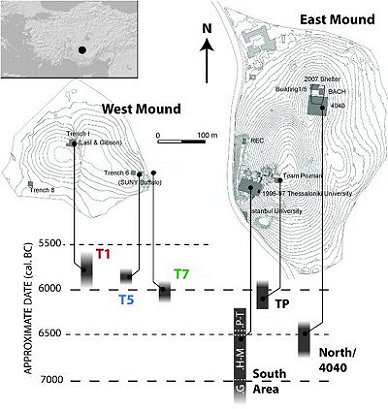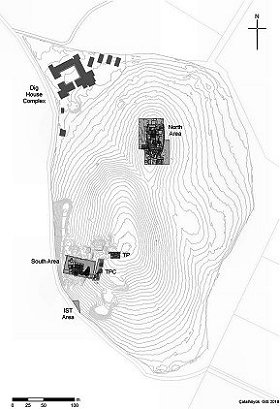| History
of Excavation
The creation of Poznañ
archaeological mission in Anatolia in 2000 and works commenced at Çatalhöyük
was the first research initiative of Faculty of Archaeology (formerly:
Institute of Prehistory) in the Near East. For eight years it had been
the only Insitutes' mission conducting archaeological excavation in the
Mediterranean Sea zone.
Research of Institute of
Archaeology AMU at Çatalhöyük started in 2001 and last until today, under
the direction of prof. Arkadiusz Marciniak. In years 2001-2011 they were
conducted in the TP (Team Poznañ) Area with cooperation with Institute
of Archaeology and Ethnology Polish Academy od Sciences, and then Insitute
of Archaeology at University of Gdansk, under the direction of prof. Lech
Czerniak. Between 2012 and 2017 the research were conducted in the new
area on the mound (TPC). In 2018 a new area, designated as East, was opened
up. Since the very beginning, the Polish research team was fully autonomical
in terms of organization and financial issues.

Polish research team was
fully interdisciplinary in character, and it included, except archaeologists,
representatives of other fields such as: zooarchaeology, paleobotanics,
physical anthropology. The project at Çatalhöyük comprises an active participation
of students leading to completion of numerous Bachelor, Master and Doctorate
dissertations.
The results of the research
are significant: they proved that in the latest phases of the mound occupation,
significant, multiscalar transformation took place. The results of the
research were published and presented at various conferences. The results
of each excavation season were presented in archive reports accessible
online at the Çatalhöyük Research Projects' website.
The participation in the
research at Çatalhöyük resulted in establishing close cooperation with
leading research centers in Turkey, including: British Institue of Archaeology
in Ankara, American Research Institute (ARIT), Deutsches Archäologisches
Institut (DAI) i RCAC (Koç University Research Center for Anatolian Civilizations)
in Istanbul; and also Albright Institute in Jerusalem and Archaeological
British Institute in Amman.
Recently, collaboration
between AMU and OREA (Institute for Oriental and European Archeology) in
Vienna was established. The project Pathways to the Late Neolithic of Central
and Western Anatolia. The case studies of Çukuriçi Höyük and Çatalhöyük
between 6500 and 6000 cal BC will be conducted in small-scale workshops
held in Vienna and Poznan to offer a discussion platform for the experts
and students of both teams.
Close relations were established
with other excavation teams in Turkey: Asikli Hoyuk (under the direction
of Mihriban Ozbasaran, Istanbul University), Tepecik Ciftlik (Erhan Bicakci,
Istanbul University) or Boncuklu Hoyuk (Douglas Baird, University of Liverpool).
History of the Excavations
The site was discovered
in 1958 British archaeologist James Mellaart and excavated between 1961
and 1965. It became famous due to its large size and spectacular wall paintings
inside the houses. Due to the richness of finds, some houses were termed
'shrines' and the anthropomorphic figurines unearthed at the sites were
interpreted as representations of Mother Goddesses.
The second phase of works
was carried out in the years 1993-2017 as the Çatalhöyük Research Project.
The international team of archaeologists and experts of different fields
was directed by Ian Hodder of Stanford University.

Melaart's first excavations,
1961-1965. |
..... |
The project
operated with a permit provided by the Turkish Ministry of Culture and
Tourism, and under the auspices of the British Institute at Ankara. The
institutional partners of the project are Selçuk University, Stanford University,
University College London, Adam Mickiewicz University, and Istanbul University.
The 25 year project aimed
at recognition of multiple aspects of existence of the Neolithic community
inhabiting Çatalhöyük- with employment of the advanced research methods
and techniques. Major objectives of the project included: reconstruction
of paleo-environment, resources procurement strategies, food production,
social organization and its connection with ritual practices, as well as
the investigation of the relation to other near eastern Neolithic communities. |
| The excavations on the
East Mound were carried in South and North Areas and were focused upon
Early Neolithic strata. The South Area included three trenches adjoining
Mellaart's deep excavations in his Areas E and F. Further to the south,
the IST Area demonstrated that the Neolithic occupation extended to the
edge of the mound. The North Area was located on the northern eminence
of the East mound. The project was also focused upon conservation and heritage
protection and management.
The Late Neolithic sequence
of the settlement occupation was revealed in TP and TPC Areas. They were
excavated by the Polish team directed by Arkadiusz Marciniak and Lech Czerniak
within the Çatalhöyük Research Project. Both Areas are located in the previously
unexplored uppermost parts of the southern part of the East mound and are
adjacent to the Mellaart's Area B. |
..... .... .... |
|
The early Chalcolithic
settlement on the West Mound was first excavated by James Mellaart in 1961
where he dug two small trenches on its top. Different parts of the mound
were excavated by teams led by Jonathan Last (Trench 1:1998-2004), Burçin
Erdogu (Trench 8:2006-2012) and Peter F. Biehl (Trenches 5-7:2006-2013)
within the Çatalhöyük Research Project. The excavation ath the West Mound
terminated in 2013.
Çatalhöyük Research Project
terminated in 2018 but the analyses and research are ongoing.
The new phase at Çatalhöyük
began in 2018 with Çiler Çilingiroglu from Ege University as a scientific
advisor. In 2018 and 2019 a new area on the East Mound was excavated by
team from Poland led by Arek Marciniak in collaboration with Çiler Çilingiroglu.
|